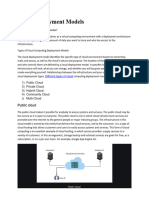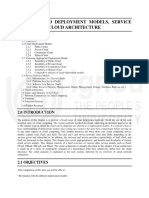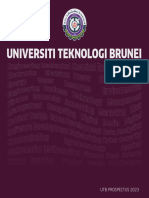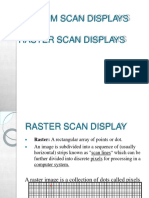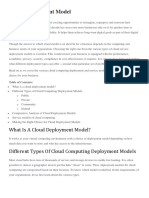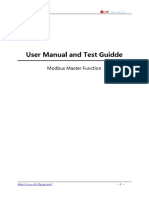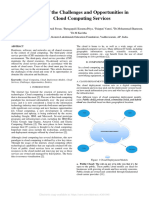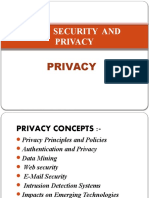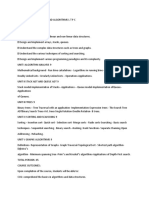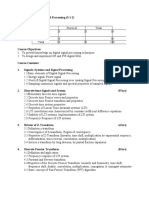Cloud Computing Lab Manual Jan-jun 2025
Uploaded by
arthurmorgan2904Cloud Computing Lab Manual Jan-jun 2025
Uploaded by
arthurmorgan2904Shri Vaishnav Vidyapeeth Vishwavidyalaya,
Indore Shri Vaishnav Institute of Information
Technology Department of Computer Science &
Engineering
B.Tech (CSE)
Subject: - INTRODUCTION TO CLOUD COMPUTING
Subject Code: - BTCS603N
Submitted by:- Submitted to:-
(NAME)…………. Prof. Gyanesh Savita
(ENROL)……………... Assistant Professor
CS-… III year /VI SEM CSE-SVIIT
Shri Vaishnav Vidyapeeth Vishwavidyalaya
Shri Vaishnav Institute of Information Technology
Department : Computer Science and Engineering
Code: BTCS603N Subject: Introduction to Cloud Computing
Session: Jan-Jun 2025 Year/Sem: III/ VI Section: …….
TABLE OF CONTENT
S.No. Name of Experiment Page No. Remarks
1. To study about cloud computing and various 1-5
deployment models.
2. To study about various cloud computing services 6-9
models.
3. To study cloud monitoring systems. 10-11
4. Install Virtualbox / Vmware Workstation with 12-18
different flavours of linux or windows OS on top of
windows7 or 8.
5. Install a C compiler in the virtual machine created 19-22
using virtual box and execute Simple Programs.
6. Install Google App Engine. Create hello world app 23-29
and other simple webapplications using
python/java.
7. Find a procedure to transfer the files from one virtual 30-35
machine to another virtual machine.
8. Find a procedure to launch virtual machine using 36-40
trystack.
9. Attach a virtual box to a virtual machine. 41-43
10. Install a C compiler in the virtual machine and 44-46
execute a sample program
EX. NO.: 1
To study about cloud computing and various deployment models.
AIM:
To study about cloud computing and various deployment models.
THEORY: Cloud computing is on-demand access, via the internet, to computing resources—
applications, servers (physical servers and virtual servers), data storage, development tools,
networking capabilities, and more—hosted at a remote data center managed by a cloud
services provider (or CSP). The CSP makes these resources available for a monthly subscription fee
or bills them according to usage. Cloud computing works by enabling client devices to access data and
cloud applications over the internet from remote physical servers, databases and computers.
Key characteristics of cloud computing include:
On-Demand Self-Service: Users can provision and manage computing resources as needed
without requiring human intervention from the service provider.
Broad Network Access: Cloud services are accessible over the internet from various devices
such as laptops, smartphones, and tablets.
Resource Pooling: Multiple customers share pooled computing resources (e.g., servers,
storage, networking) to serve multiple users or tenants.
Rapid Elasticity: Resources can be quickly scaled up or down based on demand. Users pay for
only the resources they consume.
Measured Service: Cloud computing resources are metered, and users are billed based on their
usage. This pay-as-you-go model offers cost efficiency and flexibility.
1
Various Cloud Deployment Models:
Cloud deployment models refer to the ways in which cloud computing resources and services are
made available to users. There are several deployment models, each with its own characteristics and
use cases. Cloud Deployment Model functions as a virtual computing environment with a deployment
architecture that varies depending on the amount of data you want to store and who has access to the
infrastructure. The three main cloud deployment models are:
Public Cloud: In a public cloud deployment, cloud services are provided by third-party service
providers over the internet. These services are made available to the general public or a large
industry group. The public cloud may be less secure as it is open to everyone. The public cloud
is one in which cloud infrastructure services are provided over the internet to the general
people or major industry groups. The infrastructure in this cloud model is owned by the entity
that delivers the cloud services, not by the consumer. It is a type of cloud hosting that allows
customers and users to easily access systems and services. This form of cloud computing is an
excellent example of cloud hosting, in which service providers supply services to a variety of
customers. The IT giants such as Google, Amazon and Microsoft offer cloud services via
Internet.
Characteristics of Public Cloud:
Resources are shared among multiple organizations or tenants.
Cost-effective due to shared infrastructure and economies of scale.
Scalable and flexible, allowing users to scale resources up or down based on demand.
Figure: Public Cloud
2
Private Cloud: In a private cloud deployment, cloud services are used exclusively by a single
organization. The infrastructure can be located on-premises or hosted by a third-party
provider. Private clouds are distributed systems that work on private infrastructure and provide
the users with dynamic provisioning of computing resources. Instead of a pay-as-you-go
model in private clouds, there could be other schemes that manage the usage of the cloud and
proportionally billing of the different departments or sections of an enterprise. Private cloud
providers are HP Data Centers, Ubuntu, Elastic-Private cloud, Microsoft, etc.
Characteristics of Private Cloud:
Offers greater control over resources and security, as the cloud is dedicated to a single
organization.
Suited for organizations with specific regulatory or compliance requirements.
May be more expensive than public cloud due to dedicated infrastructure.
Provides flexibility in terms of customization and configuration.
Managed by the organization itself or a third-party provider.
Figure: Private Cloud
Hybrid Cloud: A hybrid cloud deployment combines elements of both public and private
clouds. It allows data and applications to be shared between them. For this reason, they are
also called heterogeneous clouds. A major drawback of private deployments is the inability to
scale on-demand and efficiently address peak loads. Here public clouds are needed. Hence, a
hybrid cloud takes advantage of both public and private clouds.
3
Characteristics of Hybrid Cloud:
Offers greater flexibility by allowing workloads to move between public and private
clouds.
Provides a balance between the cost efficiency of public cloud and the control of private
cloud.
Useful for scenarios where certain data or applications need to remain on-premises while
others can take advantage of the scalability of the public cloud.
Requires effective integration and management of both cloud environments.
Figure: Hybrid Cloud
Community Cloud: A community cloud is a cloud computing deployment model that is shared
among several organizations with common interests, such as industry-specific compliance
requirements, security concerns, or collaborative projects. In a community cloud, the
infrastructure is shared by a specific community of users who have shared goals and
requirements. This deployment model offers a middle ground between public and private
clouds, providing a level of control and customization while allowing for shared resources and
cost benefits.
Characteristics of Community Cloud:
Resources like servers, storage, and networks are shared among multiple organizations within
a specific community.
Users in a community cloud share common goals, concerns, or industry-specific requirements.
Designed to foster collaboration and communication among participating organizations.
Organizations within the community share costs, leading to potential cost savings compared to
individual private clouds.
Offers a higher degree of customization and control over infrastructure compared to public
clouds.
Commonly found in industries with specific regulatory standards or where collaboration is
crucial, such as healthcare, finance, and government.
4
Figure: Community Cloud
RESULT:
The choice of the best cloud deployment model depends on the specific needs, goals, and constraints
of an organization. Each deployment model—public, private, hybrid, and community—has its own
advantages and is suitable for different scenarios. A hybrid cloud approach that combines the benefits
of public and private clouds may offer a good balance, allowing organizations to leverage the
advantages of both models.
5
EX. NO.: 2
To study about various cloud computing services models.
AIM:
To study about various cloud computing services models.
THEORY: Cloud computing model is used to deliver the services to end users from a pool of
shared resources such as computer systems, network components, storage systems, database servers
and software applications as a pay-as-you-go service rather of purchasing or owning them. The
services are delivered and operated by the cloud provider, which reduces the end user's management
effort.
Cloud computing allows the delivery of a wide range of services categorized into three basic types of
delivery models as follows:
Infrastructure as a Service (IaaS): IaaS is a service model that delivers computer
infrastructure on an outsourced basis to support various operations. Typically IaaS is a service
where infrastructure is provided as outsourcing to enterprises such as networking equipment,
devices, database, and web servers. IaaS is also known as Hardware as a Service (HaaS). It is a
computing infrastructure managed over the internet. The main advantage of using IaaS is that it
6
helps users to avoid the cost and complexity of purchasing and managing the physical servers.
7
Characteristics of IaaS:
Resources are available as a service
Services are highly scalable
Dynamic and flexible
GUI and API-based access
Automated administrative tasks
Advantages of IaaS:
Cost-Effective: Eliminates capital expense and reduces ongoing cost and IaaS customers
pay on a per-user basis, typically by the hour, week, or month.
Website hosting: Running websites using IaaS can be less expensive than traditional web
hosting.
Security: The IaaS Cloud Provider may provide better security than your existing software.
Maintenance: There is no need to manage the underlying data center or the introduction of
new releases of the development or underlying software. This is all handled by the IaaS
Cloud Provider.
Disadvantages of IaaS:
Limited control over infrastructure: IaaS providers typically manage the underlying
infrastructure and take care of maintenance and updates, but this can also mean that users
have less control over the environment and may not be able to make certain customizations.
Security concerns: Users are responsible for securing their own data and applications,
which can be a significant undertaking.
Limited access: Cloud computing may not be accessible in certain regions and countries
due to legal policies.
Platform as a Service (PaaS): PaaS cloud computing platform is created for the programmer
to develop, test, run, and manage the applications.
Characteristics of PaaS:
Accessible to various users via the same development application.
Integrates with web services and databases.
Builds on virtualization technology, so resources can easily be scaled up or down as per
the organization's need.
Support multiple languages and frameworks.
Provides an ability to "Auto-scale".
8
Advantages of PaaS:
Simple and convenient for users: It provides much of the infrastructure and other IT
services, which users can access anywhere via a web browser.
Cost-Effective: It charges for the services provided on a per-use basis thus eliminating the
expenses one may have for on-premises hardware and software.
Efficiently managing the lifecycle: It is designed to support the complete web application
lifecycle: building, testing, deploying, managing, and updating.
Efficiency: It allows for higher-level programming with reduced complexity thus, the
overall development of the application can be more effective.
Disadvantages of PaaS:
Limited control over infrastructure: PaaS providers typically manage the underlying
infrastructure and take care of maintenance and updates, but this can also mean that users
have less control over the environment and may not be able to make certain
customizations.
Dependence on the provider: Users are dependent on the PaaS provider for the availability,
scalability, and reliability of the platform, which can be a risk if the provider experiences
outages or other issues.
Limited flexibility: PaaS solutions may not be able to accommodate certain types of
workloads or applications, which can limit the value of the solution for certain
organizations.
Software as a Service (SaaS): SaaS is also known as "on-demand software". It is a software in
which the applications are hosted by a cloud service provider. Users can access these
applications with the help of internet connection and web browser.
Characteristics of SaaS:
Managed from a central location
Hosted on a remote server
Accessible over the internet
Users are not responsible for hardware and software updates. Updates are applied
automatically.
The services are purchased on the pay-as-per-use
basis Advantages of SaaS:
Cost-Effective: Pay only for what you use.
Reduced time: Users can run most SaaS apps directly from their web browser without
needing to download and install any software. This reduces the time spent in installation
9
and configuration and can reduce the issues that can get in the way of the software
deployment.
Accessibility: We can Access app data from anywhere.
Automatic updates: Rather than purchasing new software, customers rely on a SaaS
provider to automatically perform the updates.
Scalability: It allows the users to access the services and features on-demand.
Disadvantages of SaaS:
Limited customization: SaaS solutions are typically not as customizable as on-premises
software, meaning that users may have to work within the constraints of the SaaS
provider’s platform and may not be able to tailor the software to their specific needs.
Dependence on internet connectivity: SaaS solutions are typically cloud-based, which
means that they require a stable internet connection to function properly. This can be
problematic for users in areas with poor connectivity or for those who need to access the
software in offline environments.
Security concerns: SaaS providers are responsible for maintaining the security of the data
stored on their servers, but there is still a risk of data breaches or other security incidents.
Limited control over data: SaaS providers may have access to a user’s data, which can be a
concern for organizations that need to maintain strict control over their data for regulatory
or other reasons.
RESULT: This was the study of various service models. The organizations may choose a
combination of these service models based on their specific needs, development practices, and the level
of control they require over the underlying infrastructure.
10
EX. NO.: 3
To study cloud monitoring systems.
AIM:
To study cloud monitoring systems.
THEORY: Cloud monitoring system is automated and manual tool used to manage, monitoring and
evaluating cloud computing architecture, infrastructure, and service. Cloud monitoring is the process of
reviewing, controlling and managing the operational and active workflow and processes within a cloud
infrastructure. It is the use of manual or automated IT monitoring and management techniques to ensure
that a cloud infrastructure or platform optimize the performance of cloud. Monitoring is crucial for
ensuring optimal performance, identifying potential issues, and maintaining the overall health of cloud-
based systems. Various cloud monitoring solutions offer a range of features to help organizations track
and analyze their cloud resources. Cloud monitoring provides an efficient way to achieve this visibility
while providing an enterprise with actionable insights to improve availability and user experiences.
TYPES OF CLOUD MONITORING
The cloud has numerous moving components, and for top performance, it’s critical to safeguard that
everything comes together seamlessly. This need has led to a variety of monitoring techniques to fit the
type of outcome that a user wants.
The main types of cloud monitoring are:
Database monitoring
Because most cloud applications rely on databases, this technique reviews processes, queries,
availability, and consumption of cloud database resources. This technique can also track queries and
data integrity, monitoring connections to show real-time usage data. For security purposes, access
requests can be tracked as well. For example, an uptime detector can alert if there’s database instability
and can help improve resolution response time from the precise moment that a database goes down.
Website monitoring
A website is a set of files that is stored locally, which, in turn, sends those files to other computers over
a network. This monitoring technique tracks processes, traffic, availability, and resource utilization of
cloud-hosted sites.
11
Virtual network monitoring
This monitoring type creates software versions of network technology such as firewalls, routers, and
load balancers. Because they’re designed with software, these integrated tools can give you a wealth of
data about their operation. If one virtual router is endlessly overcome with traffic, for example, the
network adjusts to compensate. Therefore, instead of swapping hardware, virtualization infrastructure
quickly adjusts to optimize the flow of data.
Cloud storage monitoring
This technique tracks multiple analytics simultaneously, monitoring storage resources and processes
that are provisioned to virtual machines, services, databases, and applications. This technique is often
used to host infrastructure-as-a-service (IaaS) and software-as-a-service (SaaS) solutions. For these
applications, you can configure monitoring to track performance metrics, processes, users, databases,
and available storage. It provides data to help you focus on useful features or to fix bugs that disrupt
functionality.
Virtual machine monitoring
This technique is a simulation of a computer within a computer; that is, virtualization infrastructure and
virtual machines. It’s usually scaled out in IaaS as a virtual server that hosts several virtual desktops. A
monitoring application can track the users, traffic, and status of each machine. You get the benefits of
traditional IT infrastructure monitoring with the added benefit of cloud monitoring solutions.
RESULT:
This was the study of cloud monitoring systems along with its types.
12
EX. NO.: 4
Install Virtualbox / VMware Workstation with different flavours of linux or
windows OS on top of windows7 or 8.
AIM:
To Install Virtualbox / Vmware Workstation with different flavours of linux or windowsOS on top of
windows7 or 8.
PROCEDURE:
Steps to install Virtual Box:
1. Download the Virtual box exe and click the exe file…and select next button.
2. Click the next button.
12
3. Click the next button.
4. Click the YES button.
13
5. Click the install button.
6. Then installation was completed, then show virtual box icon on desktop screen.
14
Steps to import Open nebula sandbox:
1. Open Virtual box
2. File import Appliance
3. Browse OpenNebula-Sandbox-5.0.ova file
4. Then go to setting, select Usb and choose USB 1.1
5. Then Start the Open Nebula
6. Login using username: root, password:opennebula
15
Steps to create Virtual Machine through opennebula
1. Open Browser, type localhost:9869
2. Login using username: oneadmin, password: opennebula
3. Click on instances, select VMs then follow the steps to create Virtaul machine
a. Expand the + symbol
b. Select user oneadmin
c. Then enter the VM name,no.of instance, cpu.
d. Then click on create button.
e. Repeat the steps the C,D for creating more than one VMs.
16
17
APPLICATIONS:
There are various applications of cloud computing in today’s network world. Many search engines
and social websites are using the concept of cloud computing like www.amazon.com, 18otmail.com,
facebook.com, linkedln.com etc. the advantages of cloud computing in context to scalability is like
reduced risk , low cost testing, ability to segment the customer base and auto-scaling based on
application load.
RESULT:
Thus the procedure to run the virtual machine of different configuration.
18
EX. NO.:5
Install a C compiler in the virtual machine created using virtual box and
execute Simple Programs
AIM:
To Install a C compiler in the virtual machine created using virtual box and execute Simple Programs.
PROCEDURE:
Steps to import .ova file:
1. Open Virtual box
2. File import Appliance
3. Browse ubuntu_gt6.ova file
4. Then go to setting, select Usb and choose USB 1.1
5. Then Start the ubuntu_gt6
6. Login using username: dinesh, password:99425.
19
Steps to run c program:
1. Open the terminal
2. Type cd /opt/axis2/axis2-1.7.3/bin then press enter
3. gedit hello.c
4. gcc hello.c
5. ./a.out
1. Type cd /opt/axis2/axis2-1.7.3/bin then press enter
2. Type gedit first.c
20
3. Type the c program
4. Running the C program
21
5. Display the output:
APPLICATIONS:
Simply running all programs in grid environment.
RESULT:
Thus the simple C programs executed successfully.
22
EX. NO.:6
Install Google App Engine. Create hello world app and other simple web
applications using python/java.
AIM:
To Install Google App Engine. Create hello world app and other simple webapplications
using python/java.
PROCEDURE:
1. Install Google Plugin for Eclipse
Read this guide – how to install Google Plugin for Eclipse. If you install the Google App Engine Java
SDK together with “Google Plugin for Eclipse“, then go to step 2, Otherwise, get the
GoogleApp Engine Java SDK and extract it.
2. Create New Web Application Project
In Eclipse toolbar, click on the Google icon, and select “New Web Application Project…”
Figure – New Web Application Project
Figure – Deselect the “Google Web ToolKit“, and link your GAE Java SDK via the “configureSDK” link.
23
Click finished, Google Plugin for Eclipse will generate a sample project automatically.
3. Hello World
Review the generated project directory.
24
Nothing special, a standard Java web project structure.
HelloWorld/
src/
...Java source code...
META-INF/
...other configuration...
war/
...JSPs, images, data files...
WEB-INF/
...app configuration...
lib/
...JARs for libraries...
classes/
...compiled classes...
25
The extra is this file “appengine-web.xml“, Google App Engine need this to run and deploy the
application.
File : appengine-web.xml
<?xml version="1.0" encoding="utf-8"?>
<appengine-web-app xmlns="http://appengine.google.com/ns/1.0">
<application></application>
<version>1</version>
<!-- Configure java.util.logging -->
<system-properties>
<property name="java.util.logging.config.file" value="WEB-INF/logging.properties"/>
</system-properties>
</appengine-web-app>
4. Run it local
Right click on the project and run as “Web Application“.
Eclipse console :
//...
INFO: The server is running at http://localhost:8888/
30 Mac 2012 11:13:01 PM com.google.appengine.tools.development.DevAppServerImpl start
INFO: The admin console is running at http://localhost:8888/_ah/admin
Copy
Access URL http://localhost:8888/, see output
26
and also the hello world servlet – http://localhost:8888/helloworld
5. Deploy to Google App Engine
Register an account on https://appengine.google.com/, and create an application ID for your web
application.
In this demonstration, I created an application ID, named “mkyong123”, and put it in appengine-
web.xml.
File : appengine-web.xml
<?xml version="1.0" encoding="utf-8"?>
<appengine-web-app xmlns="http://appengine.google.com/ns/1.0">
<application>mkyong123</application>
<version>1</version>
<!-- Configure java.util.logging -->
<system-properties>
<property name="java.util.logging.config.file" value="WEB-INF/logging.properties"/>
</system-properties>
</appengine-web-app>
27
To deploy, see following steps:
Figure 1.1 – Click on GAE deploy button on the toolbar.
Figure 1.2 – Sign in with your Google account and click on the Deploy button.
28
Figure 1.3 – If everything is fine, the hello world web application will be deployed to this URL –
http://mkyong123.appspot.com/
RESULT:
Thus the simple application was created successfully.
29
EX.NO:7
Find a procedure to transfer the files from one virtual machine to
another virtual machine.
AIM:
To find a procedure to transfer the files from one virtual machine to another virtual machine.
Steps:
1. You can copy few (or more) lines with copy & paste mechanism.
For this you need to share clipboard between host OS and guest OS, installingGuest Addition on
both the virtual machines (probably setting bidirectional and restarting them). You copy from
guest OS in the clipboard that is shared with the host OS.
Then you paste from the host OS to the second guest OS.
2. You can enable drag and drop too with the same method (Click on the machine, settings,
general, advanced, drag and drop: set to bidirectional )
3. You can have common Shared Folders on both virtual machines anduse one of the directory
shared as buffer to copy.
Installing Guest Additions you have the possibility to set Shared Folders too.As you put a file in
a shared folder from host OS or from guest OS, is immediately visible to the other. (Keep in
mind that can arise some problems for date/time of the files when there are different clock
settings on the different virtual machines).
If you use the same folder shared on more machines you can exchange filesdirectly copying
them in this folder.
4. You can use usual method to copy files between 2 different computer with client-server
application. (e.g. scp with sshd active for linux, winscp... you can get some info about SSH
servers e.g. here)
You need an active server (sshd) on the receiving machine and a client onthe sending machine.
Of course you need to have the authorization setted (via password or, better, via an automatic
authentication method).
Note: many Linux/Ubuntu distribution install sshd by default: you can see ifit is running with
pgrep sshd from a shell. You can install with sudo apt-get install openssh-server.
5. You can mount part of the file system of a virtual machine via NFS or SSHFS on the other, or
you can share file and directory with Samba. You may find interesting the article Sharing files
between guest and host without VirtualBox shared folders with detailed step by step
instructions.
30
You should remember that you are dialling with a little network of machineswith different operative
systems, and in particular:
Each virtual machine has its own operative system running on and actsas a physical machine.
Each virtual machine is an instance of a program owned by an user in the hosting operative
system and should undergo the restrictions of the user in thehosting OS.
E.g Let we say that Hastur and Meow are users of the hosting machine, but they did not allow
each other to see their directories (no read/write/execute authorization). When each of them
run a virtual machine, for the hosting OS those virtual machine are two normal programs
owned by Hastur and Meow and cannot see the private directory of the other user. This is a
restriction due to the hosting OS. It's easy to overcame it: it's enough to give authorization to
read/write/execute to a directory or to chose a different directory in which both users can
read/write/execute.
Windows likes mouse and Linux fingers. :-)
I mean I suggest you to enable Drag & drop to be cosy with the Windows machines and the
Shared folders or to be cosy with Linux.
When you will need to be fast with Linux you will feel the need of ssh-keygen and
to Generate once SSH Keys to copy files on/from a remote machine without writingpassword
anymore. In this way it functions bash auto-completion remotely too!
PROCEDURE:
Steps:
1. Open Browser, type localhost:9869
2. Login using username: oneadmin, password: opennebula
3. Then follow the steps to migrate VMs
a. Click on infrastructure
b. Select clusters and enter the cluster name
c. Then select host tab, and select all host
d. Then select Vnets tab, and select all vnet
e. Then select datastores tab, and select all datastores
f. And then choose host under infrastructure tab
g. Click on + symbol to add new host, name the host then click on create.
4. on instances, select VMs to migrate then follow the stpes
a. Click on 8th icon ,the drop down list display
b. Select migrate on that ,the popup window display
c. On that select the target host to migrate then click on migrate.
31
Before migration
Host:SACET
Host:one-sandbox
32
33
After Migration:
Host:one-sandbox
34
Host:SACET
APPLICATIONS:
Easily migrate your virtual machine from one pc to another.
RESULT:
Thus the file transfer between VM was successfully completed.
35
EX.NO:8
Find a procedure to launch virtual machine using trystack (OnlineOpenstack
Demo Version)
AIM:
To find a procedure to launch virtual machine using trystack.
Steps:
OpenStack is an open-source software cloud computing platform.
OpenStack is primarily used for deploying an infrastructure as a service (IaaS) solution like Amazon
Web Service (AWS). In other words, you can make your own AWS by using OpenStack. If you want to
try out OpenStack, TryStack is theeasiest and free way to do it.
In order to try OpenStack in TryStack, you must register yourself by joining TryStack Facebook
Group. The acceptance of group needs a couple days because it’s approved manually. After you have
been accepted in the TryStack Group, youcan log in TryStack.
TryStack.org Homepage
I assume that you already join to the Facebook Group and login to the dashboard. After you
log in to the TryStack, you will see the Compute Dashboard like:
36
OpenStack Compute Dashboard
Overview: What we will do?
In this post, I will show you how to run an OpenStack instance. The instance willbe accessible
through the internet (have a public IP address). The final topology will like:
37
Network topology
As you see from the image above, the instance will be connected to a localnetwork and the local
network will be connected to internet.
Step 1: Create Network
Network? Yes, the network in here is our own local network. So, your instanceswill be not mixed up
with the others. You can imagine this as your own LAN (Local Area Network) in the cloud.
1. Go to Network > Networks and then click Create Network.
2. In Network tab, fill Network Name for example internal and then click Next.
3. In Subnet tab,
1. Fill Network Address with appropriate CIDR, for example 192.168.1.0/24. Use private network
CIDR block as the best practice.
2. Select IP Version with appropriate IP version, in this case IPv4.
3. Click Next.
4. In Subnet Details tab, fill DNS Name Servers with 8.8.8.8 (GoogleDNS) and then click Create.
Step 2: Create Instance
Now, we will create an instance. The instance is a virtual machine in the cloud,like AWS EC2. You
need the instance to connect to the network that we just created in the previous step.
1. Go to Compute > Instances and then click Launch Instance.
2. In Details tab,
1. Fill Instance Name, for example Ubuntu 1.
2. Select Flavor, for example m1.medium.
3. Fill Instance Count with 1.
4. Select Instance Boot Source with Boot from Image.
5. Select Image Name with Ubuntu 14.04 amd64 (243.7 MB) if you want install Ubuntu
14.04 in your virtual machine.
3. In Access & Security tab,
1. Click [+] button of Key Pair to import key pair. This key pair is a public and private key that we
will use to connect to the instance from our machine.
2. In Import Key Pair dialog,
1. Fill Key Pair Name with your machine name (for example Edward-Key).
2. Fill Public Key with your SSH public key (usually is in
~/.ssh/id_rsa.pub). See description in Import Key Pair dialog box formore information. If you
are using Windows, you can use Puttygen to generate key pair.
3. Click Import key pair.
3. In Security Groups, mark/check default.
38
4. In Networking tab,
1. In Selected Networks, select network that have been created in Step 1, for example internal.
5. Click Launch.
6. If you want to create multiple instances, you can repeat step 1-5. I created onemore instance with
instance name Ubuntu 2.
Step 3: Create Router
I guess you already know what router is. In the step 1, we created our network, but it is isolated. It
doesn’t connect to the internet. To make our network has an internet connection, we need a router
that running as the gateway to the internet.
1. Go to Network > Routers and then click Create Router.
2. Fill Router Name for example router1 and then click Create router.
3. Click on your router name link, for example router1, Router Details page.
4. Click Set Gateway button in upper right:
1. Select External networks with external.
2. Then OK.
5. Click Add Interface button.
1. Select Subnet with the network that you have been created in Step 1.
2. Click Add interface.
6. Go to Network > Network Topology. You will see the network topology. In the example, there are
two network, i.e. external and internal, those are bridged by a router. There are
instances those are joined to internal network.
Step 4: Configure Floating IP Address
Floating IP address is public IP address. It makes your instance is accessible fromthe
internet. When you launch your instance, the instance will have a private network IP,
but no public IP. In OpenStack, the public Ips is collected in a pool and managed by
admin (in our case is TryStack). You need to request a public (floating) IP address to
be assigned to your instance.
1. Go to Compute > Instance.
2. In one of your instances, click More > Associate Floating IP.
3. In IP Address, click Plus [+].
4. Select Pool to external and then click Allocate IP.
5. Click Associate.
6. Now you will get a public IP, e.g. 8.21.28.120, for your instance.
39
Step 5: Configure Access & Security
OpenStack has a feature like a firewall. It can whitelist/blacklist your in/out connection. It is called
Security Group.
1. Go to Compute > Access & Security and then open Security Groups tab.
2. In default row, click Manage Rules.
3. Click Add Rule, choose ALL ICMP rule to enable ping into your instance, and then click
Add.
4. Click Add Rule, choose HTTP rule to open HTTP port (port 80), and then click Add.
5. Click Add Rule, choose SSH rule to open SSH port (port 22), and then click Add.
6. You can open other ports by creating new rules.
Step 6: SSH to Your Instance
Now, you can SSH your instances to the floating IP address that you got in the step 4. If you are
using Ubuntu image, the SSH user will be ubuntu.
RESULT:
Thus the openstack demo worked successfully.
40
EX.NO.:9
Find a procedure to attach Virtual Box to a Virtual Machine
AIM:
To attach a virtual box to a virtual machine.
ALGORITHM:
Step1:Goto :https://sourceforge.net/projects/rf-virtualbox-lib-py/
Step2:download and copy the folder in E:drive
Step3:open the IDEnew projectjava Java project with Existing resources
41
Step4:Goto Name and LocationProject NameNext
Step5:Existing SourcesAdd FolderE:\ Robot framework virtualbox lib-1.1
Step6:Click Add FolderMycomputerE driveRobot framework virtualbox
lib-1.1open
42
Step7:Attached the virtual box in the virtual machine
Step8: Attached the virtual block to the virtual machine in the cloud sim
RESULT:
Thus virtual box has been attached with virtual machine.
43
EX.NO.: 10
Install a C compiler in the virtual machine and execute a sample program.
AIM:
To Install a C compiler in the virtual machine and execute a sample program
Algorithm:
Step1:Copy the cloudsim folder in E:drive
Step2:Open the netbeans, Newproject->C/C++->CApplication->project name->mycloud-
>finish
Step 3:right click on mycloud->properties->libraries->add jar folder->browse
(mycomputer->E drive-> unzipped cloudsim folder->jar->cloudsim3.0.3.jar file->
click ok)
44
Step 4: Go to drive E:\cloudsim- 3.0.3\examples\org\cloudbus\cloudsim\examples\
Cloudsimexample1.c
Step5: Right click on Cloudsimexample1.c and copy the code
Step 6: Open Source page in netbeans, delete the code and paste the code ( Step5)
45
Step 7: change the package name and class name as mycloud.
Step Step 8: Run ,Output Vm is created
RESULT:
Thus, the c compiler has been implemented successfully.
46
VIVA QUESTIONS AND ANSWERS
1. Define Cloud Computing with example.
Cloud computing is a model for enabling convenient, on-demand network access to a shared pool of
configurable computing resources (e.g., networks, servers, storage, applications,and services) that can
be rapidly provisioned and released with minimal management effort or service provider interaction.
2. What is the working principle of Cloud Computing?
The cloud is a collection of computers and servers that are publicly accessible via the Internet. This
hardware is typically owned and operated by a third party on a consolidatedbasis in one or more data
center locations. The machines can run any combination of operating systems.
3. What are the advantages and disadvantages of Cloud Computing?
Advantages
Lower-Cost Computers for UsersImproved Performance
Lower IT Infrastructure CostsFewer Maintenance Issues Lower Software Costs
Instant Software Updates Increased Computing PowerUnlimited Storage
CapacityIncreased Data Safety
Improved Compatibility Between Operating SystemsImproved Document Format
Compatibility
Easier Group Collaboration Universal Access to DocumentsLatest Version Availability
Removes the Tether to Specific DevicesDisadvantages
Requires a Constant Internet Connection
Doesn’t Work Well with Low-Speed ConnectionsCan Be Slow
Features Might Be Limited Stored Data Might Not Be Secure
If the Cloud Loses Your Data, You’re Screwed
4. What is distributed system?
A distributed system is a software system in which components located on networked computers
communicate and coordinate their actions by passing messages. The components interact with each
other inorder to achieve a common goal.
Three significant characteristics of distributed systems are:
Concurrency of components
Lack of a global clock
Independent failure of components
What is cluster?
A computing cluster consists of interconnected standalone computers which work
cooperatively as a single integrated computing resource. In the past, clustered computer systems have
demonstrated
What is grid computing?
Grid Computing enables virtuals organizations to share geographically distributed resources as they
pursue common goals, assuming the absence of central location, central control, omniscience, and an
existing trust relationship.
(or)
Grid technology demands new distributed computing models, software/middleware
support, network protocols, and hardware infrastructures.
National grid projects are followed by industrial grid plat form development by IBM, Microsoft, Sun,
HP, Dell, Cisco, EMC, Platform Computing, and others. New grid service providers(GSPs) and new grid
applications have emerged rapidly,similar to the growth of Internet and web services in the past two
decades.
Grid systems are classified in essentially two categories: computational or data grids and P2P
47
grids.
5. What are the business areas needs in Grid computing?
Life Sciences
Financial services
Higher Education
Engineering Services
Government
Collaborative games
6. List out the Grid Applications:
Application partitioning that involves breaking the problem into discrete pieces
Discovery and scheduling of tasks and workflow
Data communications distributing the problem data where and when it is required
Provisioning and distributing application codes to specific system nodes
Autonomic features such as self-configuration, self-optimization, self-recovery and
self-management
7. List some grid computing toolkits and frameworks?
Globus Toolkit Globus Resource Allocation Manager(GRAM)
Grid Security Infrastructure(GSI)
Information Services
Legion, Condor and Condor-G
NIMROD, UNICORE, NMI.
8. What are Desktop Grids?
These are grids that leverage the compute resources of desktop computers.
Because of the true (but unfortunate) ubiquity of Microsoft® Windows® operating system in
corporations, desktop grids are assumed to apply to the Windows environment.The Mac OS™
environment is supported by a limited number of vendors.
9. What are Server Grids?
Some corporations, while adopting Grid Computing , keep it limited to server resources that
are within the purview of the IT department.
Special servers, in some cases, are bought solely for the purpose of creating an internal
“utilitygrid” with resources made available to various departments.
No desktops are included in server grids. These usually run some flavor of the Unix/Linux
operating system.
10. Define Opennebula.
OpenNebula is an open source management tool that helps virtualized data centers oversee private
clouds, public clouds and hybrid clouds OpenNebula is vendor neutral, as well as platform- and API-
agnostic. It
can use KVM, Xen or VMware hypervisors.
11. Define Eclipse.
Eclipse is an integrated development environment (IDE) used in computer programming, and is the
most widely used Java IDE. It contains a base workspace and an extensible plug-in system for
customizing the environment.
48
12. Define Netbeans.
NetBeans is an open-source integrated development environment (IDE) for developing with Java,
PHP, C++, and other programming languages. NetBeans is also referred to as a platform of modular
componentsused for developing Java desktop applications.
13. Define Apache Tomcat.
Apache Tomcat (or Jakarta Tomcat or simply Tomcat) is an open source servlet container developed
bythe Apache Software Foundation (ASF). Tomcat implements the Java Servlet and the Java Server
Pages (JSP) specifications from Sun Microsystems, and provides a "pure Java" HTTP web server
environment forJava code to run."
14. What is private cloud?
The private cloud is built within the domain of an intranet owned by a single organization. Therefore,
they are client owned and managed. Their access is limited to the owning clients and their partners.
Their deployment was not meant to sell capacity over the Internet through publicly accessible
interfaces. Private clouds give local users a flexible and agile private infrastructure to run service
workloads within their administrative domains.
15. What is public cloud?
A public cloud is built over the Internet, which can be accessed by any user who has paid for the
service. Public clouds are owned by service providers. They are accessed by subscription. Many
companies have built public clouds, namely Google App Engine, Amazon AWS, Microsoft Azure,
IBM Blue Cloud, and Salesforce Force.com. These are commercial providers that offer a publicly
accessible remote interface for creating and managing VM instances within their proprietary
infrastructure.
16. What is hybrid cloud?
A hybrid cloud is built with both public and private clouds, Private clouds can also supporta
hybrid cloud model by supplementing local infrastructure with computing capacity from an external
public cloud. For example, the research compute cloud (RC2) is a private cloud built by IBM.
17. What is a Community Cloud?
A community cloud in computing is a collaborative effort in which infrastructure is shared between
several organizations from a specific community with common concerns (security, compliance,
jurisdiction, etc.), whether managed internally or by a third-party and hosted internally or externally.
Thisis controlled and used by a group of organizations that have shared interest. The costs are spread
over fewer users than a public cloud (but more than a private cloud
18. Define IaaS?
The IaaS layer offers storage and infrastructure resources that is needed to deliver the Cloud services.
It only comprises of the infrastructure or physical resource. Top IaaS Cloud Computing Companies:
Amazon (EC2), Rackspace, GoGrid, Microsoft, Terremark and Google.
19. Define PaaS?
PaaS provides the combination of both, infrastructure and application. Hence, organizations using
PaaS don’t have to worry for infrastructure nor for services. Top PaaS Cloud Computing Companies:
Salesforce.com, Google, Concur Technologies, Ariba, Unisys and Cisco.
20. Define SaaS?
In the SaaS layer, the Cloud service provider hosts the software upon their servers. It can be defined as
a in model in which applications and softwares are hosted upon the server and made available to
49
customers over a network. Top SaaS Cloud Computing Companies: Amazon Web Services, App
Scale, CA Technologies, Engine Yard, Salesforce and Windows Azure.
21. What is meant by virtualization?
Virtualization is a computer architecture technology by which multiple virtual machines (VMs) are
multiplexed in the same hardware machine. The idea of VMs can be dated back to the 1960s. The
purpose of a VM is to enhance resource sharing by many users and improve computer performance in
terms of resource utilization and application flexibility.
22. What are the implementation levels of virtualization?
The virtualization types are following
1. OS-level virtualization
2. ISA level virtualization
3. User-Application Level virtualization
4. hardware level virtualization
5. library level virtualization
23. List the requirements of VMM?
There are three requirements for a VMM.
First, a VMM should provide an environment for programs which is essentially identical to the
original machine.
Second, programs run in this environment should show, at worst, only minor decreases in speed.
Third, a VMM should be in complete control of the system resources.
24. Explain Host OS and Guest OS?
A comparison of the differences between a host system, a guest system, and a virtual machine withina
virtual infrastructure.
A host system (host operating system) would be the primary & first installed operating system. If
you are using a bare metal Virtualization platform like Hyper-V or ESX, there really isn’t a host
operating system besides the Hypervisor. If you are using a Type-2 Hypervisor like VMware Server or
Virtual Server, the host operating system is whatever operating system those applications are installed
into.
A guest system (guest operating system) is a virtual guest or virtual machine (VM) that is installed
under the host operating system. The guests are the VMs that you run in your virtualization platform.
25. Write the steps for live VM
migration? The five steps for live VM
migration is Stage 0: Pre-Migration
Active VM on Host A
Alternate physical host may be preselected for migrationBlock devices mirrored and free resources
maintained
Stage 1: Reservation
Initialize a container on the target host
Stage 2: Iterative pre-copy
Enable shadow paging
Copy dirty pages in successive rounds.
Stage 3: Stop and copy
Suspend VM on host A. Generate ARP to redirect traffic to Host B Synchronize all remaining VM
state to Host B
Stage 4: Commitment
VM state on Host A is released
50
Stage 5: Activation
VM starts on Host B Connects to local devices
Resumes normal operation
26. Define Globus Toolkit: Grid Computing Middleware
Globus is open source grid software that addresses the most challenging problems in
distributed resource sharing.
The Globus Toolkit includes software services and libraries for distributed security, resource
management, monitoring and discovery, and data management.
28. Define Blocks in HDFS
A disk has a block size, which is the minimum amount of data that it can read or write. File
systems fora single disk build on this by dealing with data in blocks, which are an integral multiple of
the disk block size. File system blocks are typically a few kilobytes in size, while disk blocks are
normally 512 bytes. This is generally transparent to the file system user who is simply reading or
writing a file—of whatever length.
29. Define Name nodes and Data nodes
An HDFS cluster has two types of node operating in a master-worker pattern:
a name node (the master) and
a number of data nodes(workers).
The name node manages the file system namespace. It maintains the file system tree and the
metadatafor all the files and directories in the tree. This information is stored persistently on the local
disk inthe form of two files: the namespace image and the edit log.
The name node also knows the data nodes on which all the blocks for a given file are located,
however, it does not store block locations persistently, since this information is reconstructed from
data nodes when the system starts.
30. Define HADOOP.
Hadoop is an open source, Java-based programming framework that supports the processing and
storage of extremely large data sets in a distributed computing environment. It is part of the Apache
project sponsoredby the Apache Software Foundation.
31. Define HDFS.
Hadoop Distributed File System (HDFS) is a Java-based file system that provides scalable and reliable
data storage that is designed to span large clusters of commodity servers. HDFS, MapReduce, and
YARN form the core of Apache™ Hadoop®.
32. Write about HADOOP.
Hadoop was created by Doug Cutting and Mike Cafarella in 2005. Cutting, who was working at
Yahoo! at the time, named it after his son's toy elephant. It was originally developed to support
distribution for the Nutch search engine project.
33. Definition of Grid Portal:
A Grid Portal provides an efficient infrastructure to put Grid-empowered applications on corporate
Intranet/Internet.
34. Define GAE.
Google App Engine (often referred to as GAE or simply App Engine) is a Platform as a Service and
cloud computing platform for developing and hosting web applications in Google-managed data
centers.
51
Applications are sandboxed and run across multiple servers. App Engine offers automatic scaling for
webapplications—as the number of requests increases for an application, App Engine automatically
allocates more resources for the web application to handle the additional demand.
35. What is Cloudsim?
CloudSim is a simulation toolkit that supports the modeling and simulation of the core functionality of
cloud, like job/task queue, processing of events, creation of cloud entities (datacenter, datacenter
brokers, etc), communication between different entities, implementation of broker policies, etc. This
toolkit allowsto:
Test application services in a repeatable and controllable environment.
Tune the system bottlenecks before deploying apps in an actual cloud.
Experiment with different workload mix and resource performance scenarios on simulated
infrastructure for developing and testing adaptive application provisioning techniques
36. Core features of CloudSim are:
The Support of modeling and simulation of large scale computing environment as federated
clouddata centers, virtualized server hosts, with customizable policies for provisioning host resources
to virtual machines and energy-aware computational resources
It is a self-contained platform for modeling cloud’s service brokers, provisioning, and allocation
policies.
It supports the simulation of network connections among simulated system elements.
Availability of a virtualization engine that aids in the creation and management of
multiple independent and co-hosted virtual services on a data center node.
Flexibility to switch between space shared and time shared allocation of processing cores
to virtualized services.
37. Uses of Cloudsim.
Load Balancing of resources and tasks
Task scheduling and its migrations
Optimizing the Virtual machine allocation and placement policies
Energy-aware Consolidations or Migrations of virtual machines
Optimizing schemes for Network latencies for various cloud scenarios
38. Define OpenStack.
OpenStack is a cloud operating system that controls large pools of compute, storage, and networking
resources throughout a datacenter, all managed and provisioned through APIs with common
authentication mechanisms. A dashboard is also available, giving administrators control while
empowering their users to provision resources through a web interface.
39. Define Trystack.
TryStack is a great way to take OpenStack for a spin without having to commit to a fulldeployment.
This free service lets you test what the cloud can do for you, offering networking, storage and compute
instances, without having to go all in with your own hardware.
It’s a labor of love spearheaded by three Red Hat OpenStack experts Will Foster, Kambiz Aghaiepour
and Dan Radez.
TryStack’s set-up must bear the load of anyone who wants to use it, but instead of an equally
boundless budget and paid staff, it was originally powered by donated equipment and volunteers from
Cisco, Dell, Equinix, NetApp, Rackspace and Red Hat who pulled together for this OpenStack
Foundationproject.
52
40. Define Hadoop.
Hadoop is an open-source software framework for storing data and running applications on clusters of
commodity hardware. It provides massive storage for any kind of data, enormous processing power
and the ability to handle virtually limitless concurrent tasks or jobs.
53
You might also like
- Session 1 Introduction to Cloud, Types of Cloud, Cloud DeploymentNo ratings yetSession 1 Introduction to Cloud, Types of Cloud, Cloud Deployment48 pages
- Cloud Deployment Models Service Models and Cloud ArchitectureNo ratings yetCloud Deployment Models Service Models and Cloud Architecture19 pages
- genius20_hardware_en_ver_116_250416_124436No ratings yetgenius20_hardware_en_ver_116_250416_12443650 pages
- Random Scan Displays AND Raster Scan DisplaysNo ratings yetRandom Scan Displays AND Raster Scan Displays28 pages
- Service_and_Deployment_Model_SHANI_KUMARNo ratings yetService_and_Deployment_Model_SHANI_KUMAR10 pages
- Cloud Services and Cloud Deployment ModelsNo ratings yetCloud Services and Cloud Deployment Models4 pages
- DS3231 Real Time Clock: I2C Communication ProtocolNo ratings yetDS3231 Real Time Clock: I2C Communication Protocol6 pages
- Technical Paper_Real-Time Devs commentedNo ratings yetTechnical Paper_Real-Time Devs commented8 pages
- CCT201 ASSIGNMENT Rozha Purnama Rahayu M30109210035No ratings yetCCT201 ASSIGNMENT Rozha Purnama Rahayu M301092100355 pages
- C++1x-2x Special Member Func Ons: Compiler Implicitly DeclaresNo ratings yetC++1x-2x Special Member Func Ons: Compiler Implicitly Declares1 page
- Cloud Computing: Harnessing the Power of the Digital Skies: The IT CollectionFrom EverandCloud Computing: Harnessing the Power of the Digital Skies: The IT CollectionNo ratings yet




